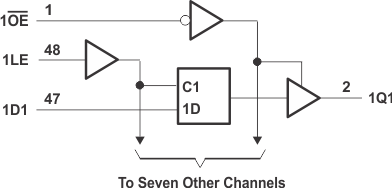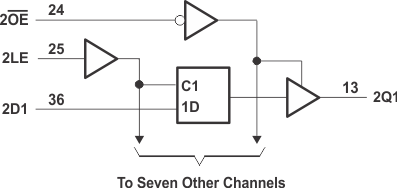SCBS778B November 2003 – June 2016 SN74LVTH16373-EP
PRODUCTION DATA.
- 1 Features
- 2 Applications
- 3 Description
- 4 Revision History
- 5 Pin Configuration and Functions
-
6 Specifications
- 6.1 Absolute Maximum Ratings
- 6.2 ESD Ratings
- 6.3 Recommended Operating Conditions
- 6.4 Thermal Information
- 6.5 Electrical Characteristics
- 6.6 Timing Requirements (I Version)
- 6.7 Switching Characteristics (I Version)
- 6.8 Timing Requirements (M Version)
- 6.9 Switching Characteristics (M Version)
- 6.10 Typical Characteristics
- 7 Parameter Measurement Information
- 8 Detailed Description
- 9 Application and Implementation
- 10Power Supply Recommendations
- 11Layout
- 12Device and Documentation Support
- 13Mechanical, Packaging, and Orderable Information
8 Detailed Description
8.1 Overview
The SN74LVTH16373 is a 16-bit transparent D-type latch with tri-state outputs designed for low-voltage (3.3-V) VCC operation, but with the capability to provide a TTL interface to a 5-V system environment. This device is particularly suitable for implementing buffer registers, I/O ports, bidirectional bus drivers, and working registers. This device can be used as two 8-bit latches or one 16-bit latch. When the latchenable (LE) input is high, the Q outputs follow the data (D) inputs. When LE is taken low, the Q outputs are latched at the levels set up at the D inputs.
A buffered output-enable (OE) input can be used to place the eight outputs in either a normal logic state (high or low logic levels) or a high-impedance state. In the high-impedance state, the outputs neither load nor drive the bus lines significantly. The high impedance state and the increased drive provide the capability to drive bus lines without interface or pullup components. OE does not affect internal operations of the latch. Old data can be retained or new data can be entered while the outputs are in the high-impedance state.
8.2 Functional Block Diagram
 Figure 5. Logic Diagram (Positive Logic)
Figure 5. Logic Diagram (Positive Logic)
 Figure 6. Logic Diagram (Positive Logic)
Figure 6. Logic Diagram (Positive Logic)
8.3 Feature Description
The SN74LVTH16373 included active bus-hold circuitry that holds unused or undriven inputs at a valid logic state. Use of pullup or pulldown resistors with the bus-hold circuitry is not recommended. Additionally, it features power up three state that will keep the outputs in high-impedance state during power up or power down when VCC is between 0 and 1.5 V. This prevents driver conflict during power up.
To ensure the high-impedance state above 1.5 V, OE should be tied to VCC through a pullup resistor; the minimum value of the resistor is determined by the current-sinking capability of the driver.
This device is fully specified for hot-insertion applications using Ioff and power-up tri-state. The Ioff circuitry disables the outputs, preventing damaging current backflow through the device when it is powered down.
Table 2. Function Table (Each 8-Bit Section)
| INPUTS | OUTPUT Q |
||
|---|---|---|---|
| OE | LE | D | |
| L | H | H | H |
| L | H | L | L |
| L | L | X | Q0 |
| H | X | X | Z |
8.4 Device Functional Modes
Device functions as tristatable 8 or 16-bit latch per function table defined in Table 2.